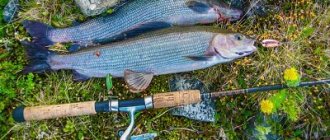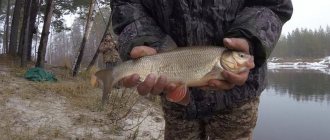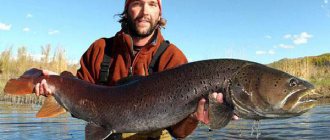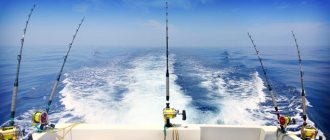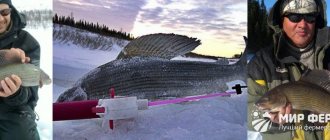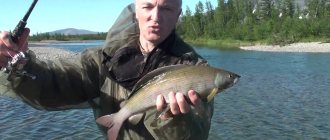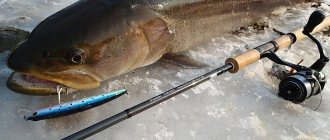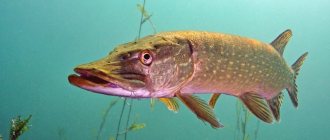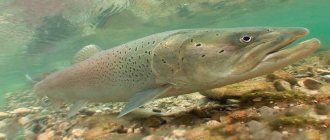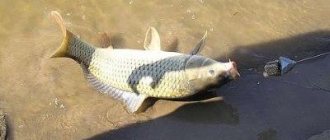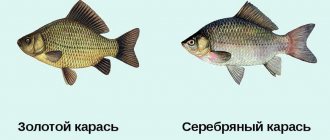Working jigs and flies for catching lenok and grayling in winter
Welcome readers of the 25 Bears site. In one of the recent reports on winter fishing for grayling from ice, we talked about working flies, places and depths where to look for grayling.
The presented fishing technique is applicable in conditions where there are thawed patches and gullies on the river. However, this approach almost eliminates the possibility of catching large lenok, which huddle in the ice-covered bays of small rivers. By adopting a drill, you can significantly increase your chances of catching trophy specimens.
Catching lenok and grayling from a hole is a whole art; there are so many places - so many approaches and ways of equipping a fishing rod and preparing bait. The Internet is not very diverse on this matter, and the reports are all carbon copies.
We have tried to prepare for you a really worthwhile way to equip a winter fishing rod for catching both lenka and grayling from a hole. Let's touch on the question of what lenok and grayling bite on in winter and where to get working bait.
Jigs for catching lenok in winter
Traditionally, jigs and spinners - “horizontals” - are used for lenka. Solder color: white, red gold and their combinations. Examples of proven working jigs in the photo:
Working jigs for catching lenok in winter
Fly jig for catching lenok
While fishing for live bait on the Ussuri River, one local fisherman suggested that lenok was actively biting on “knitted jigs.” He advised winding a fly of red (brick) or dirty pink thread about a third of the length of a soldered hook.
I had a hook with a bead at hand, and the source of the thread was the inner pocket of a red Chinese down jacket. It turned out wonderful and effective.
The difference between such a fly and a regular one is that only a third of the body of the hook is wrapped with thread. Bait is attached to the remaining part of the sting (more about bait for catching lenok below).
This knitted jig showed itself well closer to spring, specifically for lenka. The use of such a jig differs from the traditional one in that additional loading of the tackle is required. At a distance of 10-15 centimeters above the jig, a load is installed to ensure comfortable detection of the bottom and play with the bait.
Additional equipment for a winter fishing rod for grayling fishing
Fly "Bug" for catching grayling in winter
In addition to the lenkov jig for winter fishing, a fly for catching grayling is added to the tackle. When rigging, a sliding leader is used to allow maneuvering in depth.
The “Bug” fly has earned special respect from fishermen in winter (see photo). The fly is made by the famous seaside fly knitter Roman (Mr. Arsenyev, more of his flies on the Hermit’s Blog).
But grayling traditionally does not ignore its favorite colors - carrots of various shades, green dubbing, etc. Examples of flies are given in the article on fishing for grayling in the fall. Having dealt with the equipment, let's move on to the issue of bait.
Bait for catching lenok using a jig from a hole in winter
Caddisfly - bait for catching lenok in winter
Once upon a time, we thought that winter in Primorye was very mild and finding bait would not be a problem. However, when it came to the first trips, there were no bloodworms; you couldn’t find maggots during the day with fire.
When we first conquered the Primorsky expanses with jigs, the bait was small worms bought at a pet store.
Bait is extremely important in winter and can make all the difference in your fishing. So, in order about what to catch:
Attaching bait to a fly - jig for catching lenok
- The most common bait is caddis. Should I tell you about it? It is also effective when catching char in winter, and in general when fishing it is never superfluous. It is mined from fast-moving streams in both winter and summer. The photo shows a lenko sandwich made from caddisfly and the jig fly described above.
- Bark beetles are larvae that live in the bark and trunk of trees. We extract it from rotten trees - remove the bark and collect it.
- The next bait is caviar, which serves as a panacea when caddis flies and bark beetles smoke. It is worth quoting to reflect the fishing emotions:
“The caddis fly worked very poorly, only one was caught on the worm, but it attacked the eggs like a dog. “Two of them had to tear their mouths open to remove the jig.”
Caviar, as in the case of char , works flawlessly in lenka, but not all eggs are equally useful, therefore:
- caviar should be natural and not from the store. You need “oak”, specially dried from the one used for food, also called peas;
Catching lenka using the described gear
Only chum salmon caviar ; other fish seem to disdain.
The final chord is a photograph of the catch of lenok and grayling using the described gear. Everything is working, tested, use honest fishing methods.
Lenok in nets will not bring you pleasure, but a 2 kilogram flaxen on a thin line is a worthy thing!
PS: at the request of the guests, here is a photo of traditional jigs for catching lenok, which also work excellently on navaga and flounder.
Jigs traditionally working using lenok
We are waiting for reviews and comments, the discussion is also ongoing on the forum , come and visit.
Catching lenka in Primorye in winter
Winter fishing for lenka in Primorye
It is especially popular among local fishermen.
After all, this beautiful predator in coastal rivers accounts for up to 90% of all catches. However, catching lenok
is quite difficult and rarely does anyone manage to catch more than 5-6 individuals during a fishing trip.
And sometimes there are only 1-2 bites per day. Therefore, many anglers simply don't think it's worth the time and effort. And due to such circumstances, you are unlikely to meet random fishermen on the river; mostly, they are real fans of lenok fishing. Lenka is mainly caught on rivers with winter fishing rods with blind equipment.
If you intend to catch lenok weighing no more than 1 kg, then for the equipment it is better to use a fishing line with a diameter of 0.16-0.18 mm, since in winter the lenok offers much weaker resistance than in summer. If you intend to catch fish weighing 2-3 kg, then the tackle should be equipped with a fishing line with a diameter of 0.25-0.30 mm. To more accurately regulate the descent of the fishing rod, it is more practical to equip it with a reel. Since the depths where lenka are caught rarely exceed 1 m. It is also necessary that the rod whip be rigid, made of bamboo or fiberglass. And the nod should be no longer than 5 cm, made of lavsan or spring.
Winter fishing for lenka in Primorye
usually fished with large jigs; in Primorye they are called spinners for some reason. These jigs are usually used to catch perch and pike perch. They have an elongated shape. Their metal base should always be on top. They are usually made from copper, less often from brass, sometimes from silver, cupronickel or stainless steel. For small lenok weighing up to 800 g, hooks No. 6 are used, for catching large ones No. 8-10.
A jig for catching lenka has a center of gravity shifted to the front, which means that in the water such a bait will have a fairly large angle of deflection from the fishing line. A bunch of worms, a fry or a frog, as well as other baits with a relatively large volume can be attached to such a bait as bait. However, if bark beetles, caddis flies, and mealworms are used as bait, then the deviation of the bait from the fishing line is somewhat less.
It is necessary to carefully inspect the soldering of the hook. If you fish with small bait, then the hook is soldered in such a way that there are no angles towards the bait. Then there will be fewer gatherings. It is better if the hooks have serrations, then the bait will hold more firmly.
If fishing is supposed to be done with large baits, large jigs are needed and the hooks should be soldered to the jig at an angle.
Successful fishing for lenka
, quite naturally depends not only on the bait, but also on the bait that is offered to him. Most often used to catch this fish are a bunch of worms, bark beetles, caddis flies, frogs (they can be found in unfrozen streams under leaves and sticks), freshwater shrimp, salted salmon caviar (it must first be dried), small fish (minnow, minnow) or sliced fish, as well as animal liver and meat.
The most universal bait for catching lenok is a caddis fly; it can be used to bite both small and large lenok. You can also catch grayling, minnow, rudd, chebak, and largemouth using caddis flies.
Caddis flies can be caught in non-freezing rivers and streams. If you know in advance that a caddisfly lives in a river or stream bound by ice, then you can make a hole and lower a broom there on a rope made of birch branches and within a day “houses” with caddisfly larvae will stick there. You can use this method all winter and always have a sufficient amount of this universal bait on hand. On average, 12-15 individuals are enough for one fishing trip. The caddis larva should be removed from its house just before the hook is attached. The larva should be pierced along its entire body. In this case, the hook tip can be left open.
Most often fishing for lenka in Primorye
practiced specifically with this bait.
Now we can talk about places and tactics for catching lenok. With the onset of autumn, the migration of lenok begins from the upper reaches of the rivers to the middle and lower reaches. This predator spends the winter there. The lenok begins to migrate back when there is still ice, but mass migration occurs with the onset of ice drift. Winter fishing for lenka
occurs in places where the water layer is on average 0.1-1 m. These are mainly rifts, places near rifts, oxbow lakes, stagnant bays. Here the main criterion for a good place is shallow depth. Looking for lenok at depths of more than 1.5 m is a useless task.
It is also very important when going fishing to have at least a couple of drill knives in stock. If you drill in unfamiliar places, it often gets hammered into the bottom, and there may be stones there, which means the knives fail. Experienced fishermen always study the river bottom before ice freezes in those places where ice fishing for lenok
. If the reservoir is completely unfamiliar to you, it is recommended to drill fresh holes next to the old one and the holes.
There is no need to play it safe and try to drill holes and fish at depth. The probability of catching lenok in such places is very small or even equal to 0. Also, you should not stay in one place for longer than 12-15 m. Lenok is not a shy fish and if it is in a given place, the bite will happen very quickly. It is also recommended not to illuminate the holes, but to lower the jig into the water through a small hole made by the path.
Each angler has his own way of fishing for lenok, and fishing for lenok in winter
depends greatly on the current in a particular place, bait and depth. Usually there is a continuous game of bait. In this case, the jig is raised and lowered down to a distance of 2-3 cm. The vibration frequency averages 129-150 vibrations per minute.
Most Primorye fishermen catch lenka in this way.
However, when the bite is bad, you can use some tricks; for this, some anglers use such gear and methods. The fishing line is set with a diameter of no more than 0.14 mm, or better yet 0.12, it must withstand a tensile strength of at least 2 kg, a “lavsan” nod, the length of which can be adjusted. For such equipment, use a yellow “bug” jig and a hook No. 3.5-4.
Either wormwood stem larvae or red meat should be used as bait. The hole must be cleaned completely and covered with a piece of cardboard or thin plywood with a slot. The bite is determined by the “lining up” of the nod and the hooking occurs immediately. The main thing here is to withstand the first jerk of the line, which means the reel must have a correctly adjusted brake. If a second jerk occurs, it will be much weaker. Then, without stopping, drag the line to the exit from the hole with acceleration. However, already near the hole another jerk is likely. And you should pull the prey out of the hole with a hook. This type of gear can be used to catch fish weighing up to 1.5 kilos. However, frequent breaks are possible due to its “subtlety”. Also, fishing in the current with such gear will not work, but sometimes it is very necessary.
Happy fishing!
Lenka fishing in January.
Lenok does not bite well in January, but this does not mean that it is not worth catching at all. Catching January lenok is quite possible, you just need to know where to look for it and what gear to use.
Habitats.
Lenok lives only in large rivers; in small rivers you don’t even have to look for it, you still won’t find it. But no matter how paradoxical it may sound, it lives in large rivers, but at shallow depths. It spins near the shores at a depth of no more than three meters.
Lenka habitats
To find this representative of the salmon family, you need to go beyond the Urals. Lenok is found in rivers and lakes located in eastern Russia, as well as in Mongolia, China and Korea. It is best to look for fish in the upper reaches of rivers or in mountain reservoirs, where the water is crystal clear and low in temperature. Most often you have to rely on catching individuals weighing up to 1 kg, although it is also possible to bite record trophies about 70 cm long and weighing up to 5 kg.
Lenok feels great in winter. A depth under the ice of 5 cm to 1 m is sufficient for the fish to actively move in search of food. Promising points for fishing in winter are:
- river oxbows;
- bays with standing water;
- water areas near rapids;
- not deep areas of lakes.
Trying to catch this fish at a depth of more than 1.5 m is useless. Due to the fact that you have to make holes in shallow areas, the ice drill blades often bite into the rocky bottom.
If fellow fishermen have already visited a cool place, then it is best to make new holes in the ice next to the old holes. After drilling, do not remove ice slush from the hole. It is better to make a hole with a thin wooden stick through which you can lower the rig with bait without any problems.
Habitat
The bulk of individuals live and breed in the taiga rivers of Siberia and the Far East. They need clean spring water at a low temperature. Seething streams that smoothly turn into calm currents with whirlpools, and the riffles of a fast-flowing river, covered in the shadow of overhanging rocks and dense tree crowns, are the favorite habitats and hunting places for lenka.
In winter, lenok from small taiga rivers, which freeze almost to the bottom, descends into larger ones in search of deep pools, abundant in food, where they spend the entire winter time.
Fishing rod equipment
Winter fishing with lenka is suitable for both fans of vertical lures and supporters of jigs. If you assemble the tackle correctly, both spinners and jigs can count on a good catch.
- For vertical trolling, a short rod about 50 cm long is required.
- The fishing rod is equipped with a reel or the simplest inertial reel.
- The tackle is equipped with a monofilament fishing line with a thickness of 0.30-0.40 mm. The length of the thread is usually from 10 to 30 m.
- A rigid nod is attached to the rod's whip, which is adjusted for a specific lure.
Selecting spinning tackle
Catching lenok with spinning tackle in rivers and lakes can only be successful if you have high-quality fishing tools and equipment. To assemble fishing tackle for a typical predator from the salmon family you will need:
- A rod with a length of 2.5-2.7 m and a test load of 10-30 g, which will allow you to more effectively control the bait, spend less effort around various obstacles (grass, stones) in the fishing area and, most importantly, provides good shock absorption when landing prey ashore, reducing the load on the line and reel. If fishing is carried out from a boat or the coastline is close to the water, then you can use rods with a length of 2.1-2.4 m.
- The reel should be inertia-free with a spool of 2000-3000. The presence of a friction brake will weaken an aggressive predator and protect a thin fishing thread from breaking. It is recommended to purchase a reel with good line laying, sufficient smoothness and precise friction brake. Experienced fishermen choose Japanese-made models that are distinguished by their quality and reliability.
Photo 1. Inertia-free coil. - Fishing thread. The best option would be a monofilament line with a thickness of 0.4-0.6 mm, but you can also use braided line with a breaking load of 10 kg. There is an opinion that braided line is of little use for fishing in areas with gravel bottoms; there is a high probability of damage to the fishing line. But regular monofilament will last much longer; only nicks may appear on it.
Photo 2. Braided fabric with a monofilament shock leader.
What to catch lenka with
Catching this representative of salmon in winter requires using specific baits. They can be divided into several categories.
- cross-type artificial baits when fishing . In such spinners, the center of gravity is located in the middle, like a balancer. After lowering into the water, the bait takes a horizontal position. “Beetles,” “whitefish,” and “crabs” have become popular models among Far Eastern fishermen.
- Lenka jigs also have certain distinctive features These are large models with an elongated lead body. Fish respond better to jigs that have a metal plate on top and a soldered layer of lead on the bottom. Experienced fishermen make their own baits using copper or brass as a base. But silvery metals (stainless steel, cupronickel, silver) are used very rarely. Sufficiently large hooks from No. 6 to No. 12 are also soldered in.
Photo 2. Jig in the shape of a beetle.
- Among the baits, the most popular bait in winter is the caddis fly . It is mined in non-freezing streams and rivulets. Geese and stoneflies can also be found under the stones. On the shore, white grubs live in the thistle stems. And under the bark of fallen trees it is not difficult to find a bark beetle. You should also take worms, salted salmon caviar and freshwater shrimp with you. And it is best to offer a large lenok a frog.
- Particularly skillful fishermen manage to seduce lenok with artificial baits. First of all, these include various fly fishing flies . The fisherman's arsenal should include imitations of bloodworms and maggots.
Photo 3. Lenka flies.
Fly fishing flies for catching grayling, lenok and char
If you believe search engine statistics, fishermen on the Internet most often look for answers to questions about gear. They are interested in which gear is more catchy, when this gear works, and, of course, fishing technique (retrieving, hooking, retrieving and other features of use). Among all the variety of gear and methods of fishing, such a method and even fishing philosophy (let’s not be afraid of this big word) as fly fishing is gaining more and more popularity.
Our fishing tours for grayling!!!
Naturally, fishermen are interested in flies for catching grayling, lenok, trout and other types of trophy fish. To meet our readers halfway, we decided to open a section on the website about fly tying (for those who tie flies themselves) or about the rules for choosing flies (for those who buy them in specialized fishing stores or departments). All flies are adapted for fishing for grayling, whitefish, lenok, and trout in the rivers of the Northern and Subpolar Urals. Thanks to our guides, as well as clients and simply fishing enthusiasts (who, we really hope, will read these articles), this section of our website will be replenished with more and more new articles and photographs, will develop and grow, new and creative wet and dry flies for fishing will be published. fly fishing In this article, the first of this series, we simply want to show the most catchy flies in our experience for grayling, lenok and trout. All the flies described below can be tied by yourself (and thanks to their simplicity, you can tie even on a pond) or purchased at fishing stores.
Fly "Purple Chameleon"
This fly was deliberately designed specifically for catching grayling and whitefish, but, oddly enough, it worked best when catching lenok. This is quite strange, because... when knitting it, a rather small hook for lenka was used - Kamatsan B-110 No. 14. This fly was tested while fishing on the Lemva, Pechora, and Usa rivers. Other bodies of water have not yet been tested.
"Beige" front sight
One thing can be said about this fly - it is a mystery fly. Its main feature is that it works for a very limited period of time, and then stops working completely. Literally today, tomorrow or the day after tomorrow it is very catchy, and the next day you may not see a single bite. The “Beige” fly works only in open water and there are 2-3 “working periods” during the fishing season. Apparently, this is due to some seasonal changes in the food supply of grayling (this is what this fly works best for). We recommend that you always have such a fly in stock, especially since it is usually made of very strong hair and is very resistant to wear. When knitting it, a Kamatsan B-110 hook No. 16-14 is used.
Fly "Swamp Devil"
The catchability of this fly extends mainly to lenka. When moving along the surface of the water, its whiskers give good traces in the form of a “forewater wave”, to which the large flax reacts very well. Both trout and char rarely bite on it. Overall a good working and fairly versatile fly. It was tested on the rivers of the Subpolar Urals. When knitting, use Kamatsan B-110 hook No. 10-6
Front sight "Bronze"
The fly belongs to the category of classic dry flies for fly fishing for grayling. Simulates an insect hatching from a cocoon (the most vulnerable period in the life of any insect). Almost the entire fishing season is open - from June to November (naturally, we are talking about the rivers of the Urals). The hook was used from the Kamatsu B-110 size range No. 14-10.
Fly "Wine"
The fly works exclusively for grayling and only for it - all other inhabitants of the Ural reservoirs ignore it. Why this happens is very difficult to say. This fly showed very good results on the Lemva River and on the Khulga River (not for European, but for Siberian grayling). Kamatsan B-110 hook No. 16 was used
Fly "Yellow Stripe"
Probably the most incomprehensible and illogical fly presented in this article. It is not clear what it imitates and what it looks like. But, oddly enough, it is catchy and quite functional. Grayling, char, and lenok bite on it quite consistently. This fly showed excellent results on the rivers of the Subpolar Urals. It operates mainly in autumn, from September to November. Works especially well during the period of hunger (before freeze-up). Hook Kamatsu V-110 No. 16-14.
Fly "Red Ant"
The Red Ant fly shows very good results on small taiga rivers, one might even say that it is more likely not on rivers, but on streams. For example, this fly worked well on the Paga, Haruta, and Grubeyu rivers. On these rivers it “worked” very well specifically for grayling. The period of maximum results for this fly is August-November. Hook Kamatsan V-100 No. 12-14.
Fly "Lemon Stonefly"
The “Lemon Stonefly” fly was tested by our fishermen on rivers such as the Vishera (on the territory of the Vishera Nature Reserve), Vels, Kolva, and Ulvich. You can safely call it a grayling fly. Lenok (on the rivers of the Subpolar Urals) did not react so actively to it. A Kamatsan B-110 hook No. 14 was used.
Front sight "Lemon Ranger"
This fly continues our "lemon" series (due to the color of the materials used). The fly was associated relatively recently and the statistics on it are still small. We can definitely say that this is a universal fly for grayling and it definitely has the right to a place in every fly fisherman’s kit. Her element is grayling fishing. When producing the Lemon Ranger fly, a Kamatsu B-110 hook No. 16-14 was used.
Fly "Bear tobacco"
This fly has proven itself very well when catching large trophy grayling and lenok. Char and trout also do not shy away from it (but to a much lesser extent). The "Bear Tobacco" fly works well on all rivers of the Subpolar Urals (Lemva, Paga, Pechora, Usa, Kharuta, Grubeyu, Kozhim, Kosyu, etc.). The fly works throughout the fishing season - from June to November. The Kamatsan B-110 hook No. 12-8 is used.
Fly "Olive"
The author of this article can safely say that the Olive fly is his favorite fly when fishing for grayling. All fishing begins with this. “Olive” is probably the most versatile of all the flies for grayling. Its calm color scheme, small hook, simplicity of execution (which means reliability, accuracy and great wear resistance) made it the most effective when fishing for grayling on the Paga and Lemva rivers (Subpolar Urals). From time to time, lenok was also caught on it. As mentioned above, it is better to “sharpen” it for fishing for grayling, which means using a small hook Kamatsan B-110 No. 16.
Fly "Peach Stonefly"
This fly showed good results during autumn fishing, when the grayling began to eat. Grayling literally swallowed it to the guts in October-November. And this despite the fact that initially it was made on Lenka with a rather large hook Kamatsu B-110 No. 12-8.
Tactics and fishing techniques
When fishing for lenok, the main tactic is to continuously search for fish. Even if you manage to catch a flock, the bite does not last long. The fish may get scared while catching a relative or simply change its feeding place. Therefore, in the absence of bites, it makes no sense to linger on one hole. If you managed to remove one or more lenks from the hole, it is useful to leave it for a while. Perhaps the fish will calm down and bite the offered bait again.
Sharp, confident bites usually occur after freezing and at the end of winter. During the dry winter period, it is necessary to strike even when the nod is slightly raised or lowered.
Fans of sheer lures who decide to catch lenok should forget those fishing lines that helped them catch pike, perch or pike perch. The main technique for vertical trolling in winter is moving the bait at the bottom. It is enough to lower the spoon to the bottom and tap it at different frequencies to raise a column of turbidity. The fish's reaction to this action will not be long in coming. A characteristic moment of a bite is the fish’s preliminary pressing of the spinner to the bottom. Only after this does the lenok grab the prey into its mouth.
Jig fishermen also don’t have to sit idly by when catching lenok. The key to success in fishing will be continuous play with bait. The fisherman needs to make small high-frequency vibrations with the jig with a smooth rise to a height of 2-3 cm. The same technique is performed when lowering the bait. A prerequisite for the game is stopping at the top and bottom points. It is during the pause that the lenok often attacks.
Many anglers have to prepare in advance for lenka fishing. It is important to choose the exact time of vacation, pack a set of gear for the trip, and work out the route. But all these hardships will be fully compensated by interesting fishing and the incredible fight of the lenok for its life. After such a trip, more than once there will be a desire to visit Siberian or Far Eastern reservoirs again.
Fishing method
To attract the attention of the fish, you need to lower the jig to the bottom, fix the line at the end of the fishing rod, and with a small twitch of the brush (“play”), lift the bait 5-10 cm up for 2-3 seconds, then let it fall to the bottom again. Such movements are repeated until the bite occurs with a short interval.
If you feel a small bite, and in winter the fish is half asleep, although it is difficult to say about lenka, you should not expect sharp jerks, as in the summer, you need to quickly hook it and bring it onto the ice.
You shouldn’t stay too long on one hole, lenok is an attentive and cautious fish and, sensing something is wrong, can leave at any moment if there is a way out of the hole or give up the bite. Therefore, after 1-2 successful conclusions, it is best to let the fish calm down, and you can continue fishing by drilling another hole a few tens of meters away and try your luck there.
Read! Catching sabrefish in winter
Catching lenka: what's unusual
Lenok is an inhabitant of fast rivers with cold water.
Some fishing rod lovers purposefully go to Siberian or Far Eastern reservoirs to catch this lively fish.
The fish can reach the five-kilogram mark with a length of up to 70 cm. However, most often specimens in the weight category up to 1 kg are caught on the hook. Lenok is active throughout the year, so fishermen can catch it using both summer fishing rods and ice fishing gear.
When preparing for fishing, a beginner needs to collect gear that is best suited to the existing conditions of the reservoir and the season.
Fishing for lenok in open water
From early spring until freeze-up, you can hunt for lenok using summer fishing rods. Fishermen use several main types of gear for fishing.
For spinning
The most popular method of catching lenok in open water in rivers and lakes is spinning. From a young age, fish exhibit predatory habits, hunting for small things. For successful fishing, a novice spinning angler should assemble a catchy fishing rod.
Since uniform wiring is usually used for catching lenok , there are no special requirements for the rod. Even old telescopic fiberglass fishing rods can successfully cope with casting bait and landing fish. The length of the rod depends on the characteristics of the reservoir. If the coastline allows you to get close to the water, then you can use short spinning rods of 2.1-2.4 m. These rods are also good for fishing from a boat. When there are obstacles along the coastline in the form of thickets of grass or rocky ridges, it is more convenient to work with spinning rods of 2.7-3.0 m.
A spinning reel with a 2000-3000 spool is placed on the rod. A friction brake will help tire out a large lenok and keep a thin line from breaking.- When fishing for lenka, you can use monofilament fishing thread , which is not visible in clear water. In this regard, braid is inferior to monofilament. And the weight of the fish usually rarely exceeds 1 kg, so a nylon fishing line with a thickness of 0.20-0.25 mm will be the best option.
Among spinning lures, oscillating and rotating spoons have proven themselves to be the best when fishing for lenok. For river fishing, heavy spoons (20-30 g) or castmasters are required. In shallows and in calm water, spinners up to 40 mm long with tees No. 8-10 work great. The color of the spinners depends on the food supply in a particular body of water, as well as on weather conditions.
On the bottom fishing rod
The traditional method of catching lenok is bottom fishing. Today, such fishing rods are used mainly by local fishermen who have limited funds to purchase expensive fishing rods and artificial baits.
Thanks to a simple hook, you can successfully fish from the shore.
- Even novice fishermen can make a bait donkey. To complete the gear, you will need a strong fishing rod 1.5-2.5 m long. This can be a fishing rod made of fiberglass or aluminum.
- You can equip the donk with an inertial reel of the “Neva” type or a reliable “meat grinder”.
- The length of fishing line with a diameter of 0.5-0.6 mm is limited to the range of 20-30 m. Leaders are made of monofilament 0.3-0.4 mm with a length of 15-30 cm.
- The weight of the sinker is selected according to the strength of the current or the casting distance of the equipment. For river fishing, a flat weight weighing 40-60 g is suitable.
- The leashes are equipped with hooks with a long shank size No. 7-8.
When fishing, 3-4 hooks are used; ordinary worms cling to the hook. Lenok greedily grabs the bait lying on the bottom and swallows the hook deeply. So you don’t have to be distracted from the fishing process.
Surface fishing
With the appearance of the first insects, lenok production begins at the surface.
This method of fishing requires a fly fishing rod or boat-type gear.
In the case of fly fishing, artificial flies are usually used, and when fishing with a boat, fishermen use natural insects.
- The main elements of a fly fishing rod are the rod, reel and line. Buying all these fishing accessories in a city store will not be difficult. But not all even experienced fishermen manage to master the technique of casting the lightest baits. It is more convenient to cast while in the water. So a fly fishing enthusiast will need a special waterproof overall, waders, and a short landing net.
- Those beginners who are not ready to invest a fairly large amount of money in a dubious event can be advised to construct a homemade “boat” design . This gear is easy to make from dense wood, foam plastic, plastic, etc. Drawings or sketches of devices called “boat”, “sleigh” or “kite” are easy to find on the World Wide Web.
Choosing gear and bait for winter fishing
Fishing rod
The main attribute of any fishing is a fishing rod. Fishermen have a huge opportunity to choose this tool for ice fishing. There are five main types:
- Live bait.
- Mormuscular.
- Deliveries.
- Donkey.
- Float
From these names the purpose and application of each is clear. For catching lenka, any one is suitable to one degree or another, it all depends on the requests of the fishermen.
Most fishermen use jig rods in winter, using jigs as bait.
Read! Catching large rotan from ice
Jigs
This bait is made by combining a sinker and a hook in a monolithic manner. They can be used with or without bait. Their types vary in color, size and shape. Jigs of the “droplet” type are widely used for catching lenok.
To obtain a trophy, in most cases, brass, copper and silver jigs (number 5-7) are used, depending on the depth of the reservoir.
fishing line
When preparing for winter fishing, special attention is paid to the selection of fishing line. It will be used in extreme cold conditions and clear water.
Lenok is a cautious fish, so it is necessary to use a thin, but at the same time strong fishing line that is not noticeable in a bright reservoir.
When fishing with a jig, it is necessary to equip a fishing line with a diameter of 0.15-0.2mm. A larger cross-section of the fishing line can affect the “game” of the bait. In most cases, monofilament fishing lines meet all these requirements.
Bait
Live bait (borm, bark beetle, maggot, caddis fly, bloodworm) greatly increases the chance of a bite. Bait can be purchased in specialized stores or produced independently.
Boer
A necessary tool for drilling holes in ice. The diameter of the drill is selected depending on the size of the fish living in the reservoir. For catching lenok, the universal size will be 130mm. With this hole size you can catch fish of a fairly decent size.
Scoop
Tackle used for cleaning the hole from slush and fishing line from ice. After all, it’s not comfortable to do this with your bare hand in the cold. It is preferable to use metal scoops, which are stronger and more effective for breaking ice.
Hook
A piece of equipment used to fish fish out of a hole. Models with handles made of hard materials are best suited for this. When catching lenok in winter, be sure to have a hook with you, since there are known cases of catching lenok over two kilograms.
Read! Fishing for roach on the first ice
Catching lenok in winter
Catching lenok from under the ice in winter is very exciting.
This fish remains active in the cold season, continuing to feed in the bottom layer. Experienced ice fishermen use several methods of catching lenok in winter.
Sheer lure
Catching lenok using spinners in winter differs significantly from fishing for predators such as pike or perch. This applies not only to the appearance and weight of the artificial bait, but also to the technique of its placement.
- A fishing rod for ice trolling consists of a short rod (40-50 cm) equipped with a reel or a simple reel.
- The supply of monofilament should exceed the fishing depth, and the thickness of the thread depends on the size of the likely trophy. Typically these parameters look like this:
- length 20-30 m;
- thickness 0.3-0.5 mm.
Trolling can be carried out at different depths using transverse models. When lowered into the hole, the bait takes a horizontal position.
Unlike the usual tossing of a spoon when fishing for pike, the lenka fishing technique looks like stirring at the bottom. The bait is lowered to the bottom surface and, with the help of a fishing rod, it is given such a movement that turbidity forms under the hole. Lenok often first presses the prey to the bottom and then grabs it into its mouth.
On the jig
You can tempt the lenka to bite with the help of jig tackle. In different regions of the country, fishermen use the most unusual designs of fishing rods. A beginner can begin mastering ice fishing for lenok using a jig by assembling a simple fishing rod.
A regular plastic fishing rod and reel is fine for fishing. You should pay attention to the length of the nylon whip. The optimal parameter is considered to be 15 cm or less. This value will be enough to dampen the first jerks of a large lens. The nod is selected taking into account the weight of the jig.- To equip a jig fishing rod, a thin fishing line is required. This is explained by the fact that as the thickness of the thread increases, the performance of the bait worsens. This has a particularly negative effect when fishing with artificial flies. The most balanced tackle will be with a fishing line of 0.20-0.22 mm.
- You shouldn’t go too small with the size of the hook. The jig should be made from models No. 6-7 with a thick fore-end. Then a trophy fish weighing 1.5-2.5 kg will not be able to bend or break the wire.
- For fishing with a jig rod, both artificial baits (flies) and natural baits are used . In winter, lenok reacts well to a worm, burdock moth larva, caddisfly, bark beetle, bormysh, etc. To attract the attention of the fish to the bait, experienced jig fishermen tie yellow, brown or red woolen threads to the hook.
After all, sometimes you have to travel thousands of kilometers to do what you love. But all the inconveniences and difficulties will be compensated by the good bite of the lenok and the desperate struggle of this small fish during fishing.
Such moments remain in the memory for a long time, and a year later a strong desire to go to a Siberian or Far Eastern river to hunt for lenok appears again.
What else can you use to catch lenka?
You can interest an aggressive predator with an artificial mouse.
This is a unique invention of resourceful fishermen. It can be made from wood or foam. The optimal bait size is 10 cm in length, weight 40-75 g. But they are also caught on larger structures with a size of 18 cm and a weight of over 120 grams. Volumetric devices are more suitable for catching trophy taimen. The mice are equipped with sharp treble hooks. It is better to use them in the dark. It is first necessary to study the fishing site. The casting of an improvised rodent is carried out at a distance of 30-40 m from the coastline. For information!
It is better to use an artificial rodent on lenka in deep reaches, river bends and holes. It is necessary to cast such a device in such a way that after landing it creates a splash of water, which is guaranteed to attract the attention of a predator. During the fishing process, the fishing line is gradually tightened and pauses are made so that from the outside it looks as realistic as possible. Considering that artificial mice are mainly caught by trophy specimens, the fishing thread must be of high quality and reliable.
Another option for catching a predator is hunting with an artificial fly. To do this, you will need a fishing tool with a length of up to 5 m, a fishing line with a cross-section of up to 0.25 mm, its length should be 2 m greater than the length of the rod. A pellet is mounted slightly above the hook to improve casting quality. The artificial bait used should look like insects flying along the river bank. The opening of the season in the spring will depend on the time the first insects appear.
The fishing process itself consists of fishing various promising places, where, after casting, the bait is slightly tugged and pulled towards you. The main thing is that it constantly stays in the upper layers of water. After making a series of casts in one area of the reservoir, the fisherman goes downstream to examine other promising areas.
For information! You shouldn't stay in one place for a long time. The more areas are fished, the higher the chances of catching a predator.
After the arrival of autumn frosts, the flight of insects stops, therefore, catching lenok with artificial bait becomes irrelevant. At this time, the fry works better. A long fishing tool is suitable for such hunting. The bait is attached to a hook, piercing the back behind the head so that the sting comes out through the abdomen.

